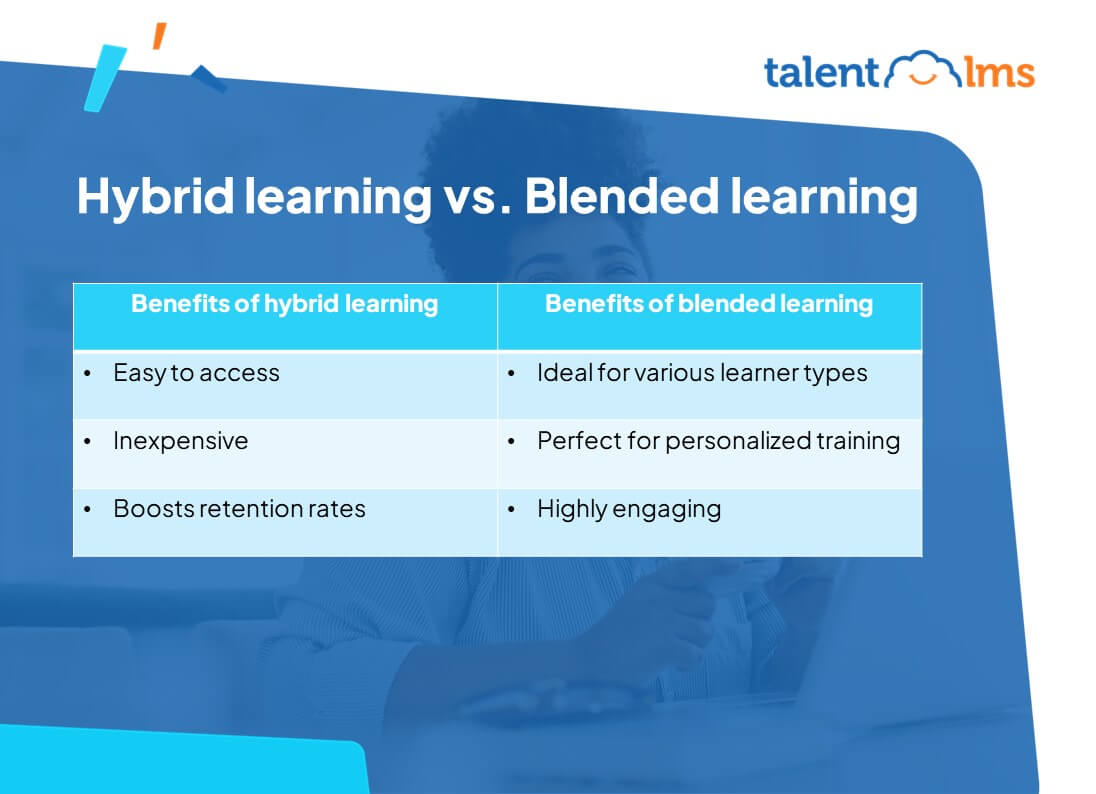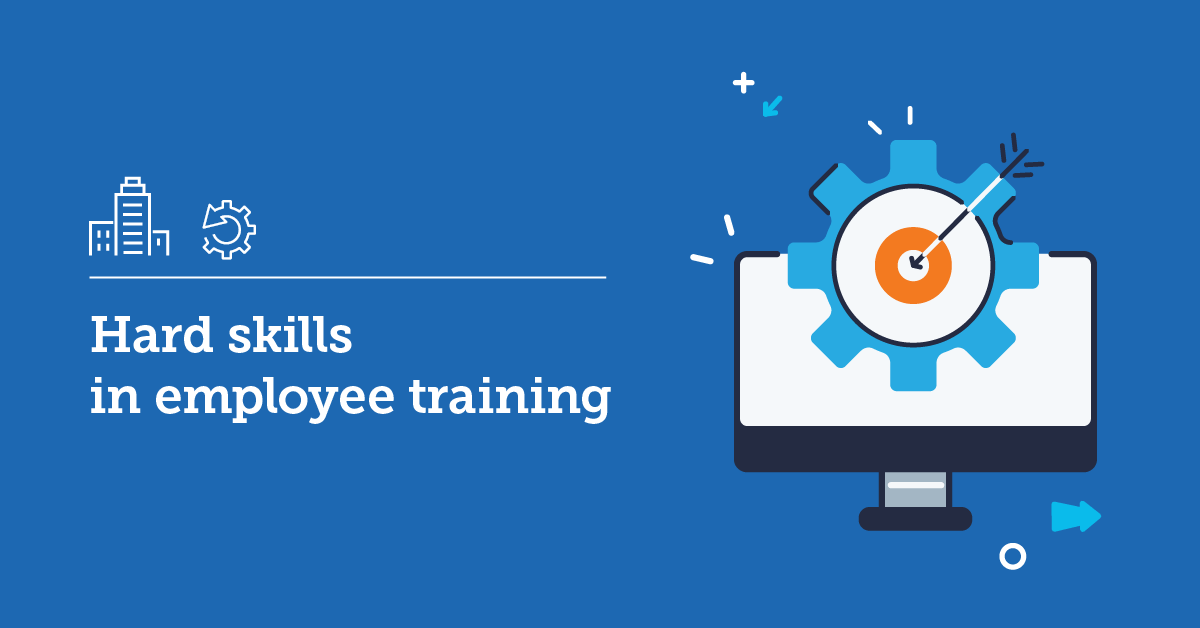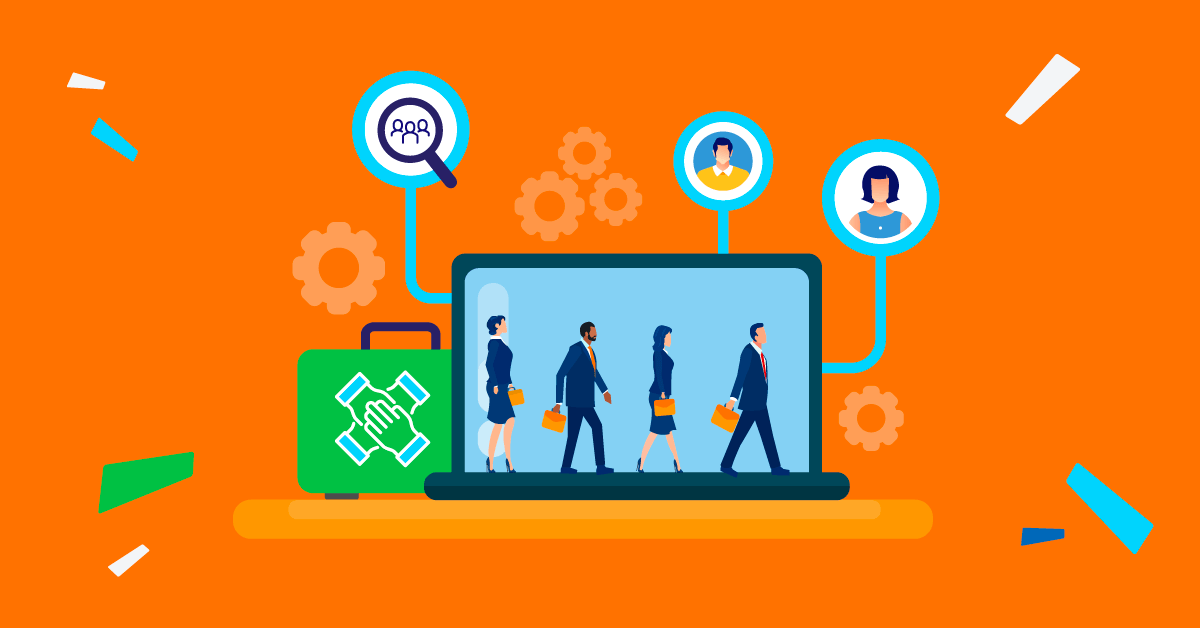The way we work has drastically changed over the past few years.
And these new work models, like remote work, work from anywhere, and hybrid work, combined with new, innovative technologies have also resulted in new training models.
Meaning the way we learn has also changed.
But to make the right choice, it’s essential to understand the difference between the emerging training models, especially hybrid learning vs. blended learning, so that organizations can offer meaningful training for successful team development.
For example, a common misconception is that hybrid learning vs. blended learning has no difference.
The confusion makes sense, as the names are similar, and both suggest combining ideas for training. But they’re not identical. Neither do they cover the same training needs.
In order to decide whether it’s worth implementing them in your training strategy and your LMS, it’s mandatory to define each one by exploring their differences and qualities.

What is hybrid learning?
Hybrid learning is a synchronous type of learning where people participate in training in-person and online at the same time. Hybrid learning has risen in popularity, as it reduces failure rates by 20%.
During hybrid learning, some learners physically attend a classroom (conference room, training room, or another designated training space), while others attend the training session virtually.
The instructor presents to those attending in person and virtually simultaneously.
For hybrid learning to be successful and effective, the instructor should use the right video conferencing tools to make training accessible to virtual learners. It’s essential to provide everyone the same chance to delve into the course.
Also, the instructor should have the right skills to make sure that both groups can equally participate. Besides having the right infrastructure, instructors need, for example, to be mindful of technical difficulties and repeat questions from the in-person so that online participants don’t feel left out of the discussion.
This is why hybrid learning sessions must be prepared in advance, have seamless connectivity, and have the right tools to support them, and the instructors.
Facilitate synchronous training no matter where employees are
Deliver hybrid learning sessions with TalentLMS.
The training platform that users consistently rank #1.
What is blended learning?
Blended learning is a type of training that combines traditional, in-class, instructor-led training with online, self-paced content for more flexible learning.
During blended learning, learners attend in-person training sessions in a designated training space and then supplement their training with online training material through an LMS or another eLearning platform. By combining the two learning methods, learners are more engaged and committed to learning. And this happens because blended learning is ideal for accommodating different learner types.
Learning is synchronous when learners attend in-class training, and they gain valuable insights from face-to-face feedback, hands-on activities, and peer interaction. However, during online training, where learning is asynchronous, learners can complete their modules in their own time based on a specific deadline set by the instructor. In this setting, learners benefit from learning at their own pace, the time, and space they prefer.
Note that it’s possible to have blended learning even if the instructor-led session is online, as long as it’s synchronous and combined with asynchronous, self-paced learning.
With blended learning, learners have the opportunity to come across advanced and more interactive online training content. Course content becomes more engaging and interesting through video, audio, quizzes, and discussion boards. Together with the in-person experience of traditional training, blended learning is currently one of the most popular learning methods and ideal for hybrid work settings.
Meet TalentLibrary™
A growing collection of ready-made courses that cover the soft skills
your teams need for success at work
![]()

Exploring the differences between hybrid learning vs. blended learning
There’s no one-size-fits-all approach to learning. Not everyone learns the same way. It is essential to provide learners with the necessary tools and methodologies to grow, develop, and succeed.
Thus, understanding the differences between hybrid learning vs. blended learning is the first step you need to take to create an inclusive learning environment for your people.
Overall, hybrid learning provides a balance between online and offline learning by catering to the needs of those who can’t physically attend a designated training space. On the other hand, blended learning combines traditional and online learning models to complement the overall learning experience.
But in order to delve deeper into what each learning model has to offer, it’s crucial to have a better grasp of the benefits they offer.

Benefits of hybrid learning
- Easy to access: Hybrid learning offers in-person and remote learners the same access to the class. As a result, more people can attend the training sessions and commit to learning and development. This learning model is rather inclusive for learners who can’t physically attend training due to location barriers, illnesses, or other personal circumstances, as they have the opportunity to attend online and not miss the full training experience.
- Inexpensive: Getting all learners to attend an in-class training session can be costly. Imagine having a large group of customers fly in from all over the world to attend a customer education program in a conference room–it would cost a fortune to cover travel expenses, book a larger venue, and accommodate everyone. Instead, with hybrid learning, you stay on budget by eliminating costs, printed materials, etc., without compromising the learning experience.
- Boosts retention rates: Not everyone learns the same, meaning there’s no one-size-fits-all approach when it comes to learning. There are learners that thrive on self-paced learning, while others do better when learning in traditional settings with peers. Hybrid learning allows learners the freedom to engage with training online or in person. As a result, they tend to participate more in training and retain knowledge at a higher rate.
Benefits of blended learning
- Ideal for various learner types: As mentioned above, not everyone learns the same way. Some people are better with visual input, while others prefer video or audio formats when it comes to digesting information easily. Blended learning is an inclusive method of learning that accommodates different learning styles so that learners can do their absolute best.
- Perfect for personalized training: During the in-class training, all learners receive the same instructions and activities (or with little differentiation). But during online training, instructors can customize ahead of time any activities, assessments, modules, and training content to meet the different learning needs of their learners.
- Highly engaging: More advanced and interactive training content can grab learners’ attention because of its various stimuli. Thus, online training modules, in combination with a traditional learning environment, can do wonders for the engagement and participation of learners.
Personalize employee training with TalentLMS
Combine interactive and self-led sessions to increase learner engagement.
Easy to set up, easy to use, easy to customize.
Which is the best learning model for an inclusive learning environment?
It would be great to answer this question in a heartbeat. But there’s no such thing as the perfect learning model that includes all.
However, organizations can find the approach that best suits their learners and specific needs.
Caring for and providing learning in a way that your people can perform their best is what creates an inclusive learning environment.
Let’s explore some useful tips for deciding on the best learning model for your needs:
- Focus on the work model: First, organizations should reflect on their work models. For example, in the case of a fully remote work environment, neither blended nor hybrid learning is ideal. But hybrid or blended learning are suitable options if a business runs on a hybrid work model. Or, if you want to include job shadowing or mentoring/coaching (learning models created initially for in-person learning), you can transfer them online through your LMS by leveraging video conferencing tools and messaging apps.
- Analyze employee learning needs: How do your people learn? In which way do they best take information in? What engages and motivates them? Are there any people with disabilities among your teams? These are some focus questions for your learning needs assessment. Run surveys and discover what your teams prefer when it comes to learning models.
- Ask for feedback: Always ask your people for their honest, constructive feedback after you implement a learning model. Send out a post-training feedback form, or run surveys to gain insights on whether the learning models you’ve adopted are effective for your teams.
Learning for all for a brighter future
There’s no right or wrong choice between hybrid learning vs. blended learning.
The key goal is to include everyone in the learning process. And to achieve that, you want to provide effective, engaging, and meaningful training for your learners.
Selecting the right model between hybrid learning vs. blended learning needs careful consideration and planning. Design courses, instructions, and online resources and activities that reach people who learn or work in different ways by having in mind how to improve the learning experience and knowledge retention.


![Skills Gap Analysis Template: Identify Training Needs [Downloadable Spreadsheet]](https://images.www.talentlms.com/blog/wp-content/uploads/2021/01/TLMS_20230612a_1200x628.png)

Leave a Reply